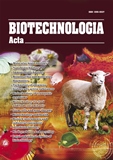ISSN 2410-7751 (Print)
ISSN 2410-776X (Online)

Biotechnologia Acta Т. 16, No. 3, 2023
P. 65-69, Bibliography 16, Engl.
UDC: 664.9; 639.21
DOI: https://doi.org/10.15407/biotech16.03.065
Full text: (PDF, in English)
LOSS OF AN ABUNDANT QUANTITY OF RIBONUCLEIC ACID DURING MINI COLUMN ISOLATION METHOD
Sudhir Bhatia
Genekam Biotechnology AG, Duissernstr. 65a, 47058 Duisburg
Aim: The Isolation of nucleic acid is an essential step for conducting different molecular assays in many laboratories around the world. It is also a common practice that the user is isolates the ribonucleic acid (RNA) from the samples with a mini column once and throws away the supernatant. This makes isolated RNA as a limiting factor in many studies, as this issue has not been addressed in literature. Therefore, we decided to conduct whether it is a loss of ribonucleic acid during the mini column isolation method.
Method: In this research, the mini-column isolations were done with different samples of human tissues from the placenta and umbilical cords and subsequent isolations of supernatants. Yields and successful isolations of RNA were assessed with the spectrometric instrument and realtime PCR machine.
Results: It was found that there was a loss of an abundant quantity of RNA during the subsequent isolations. The amount measured with a UV spectrometer indicates that some times 2nd and 3rd isolation have more RNA than the first isolation. Realtime PCR for housekeeping gene beta-actin shows that the presence of RNA can be seen up to 6 isolation cycles from supernatants.
Conclusion: There is a loss of RNA in subsequent isolations with the mini-column method. Therefore, it is possible to isolate more RNA from subsequent supernatant isolations. The user should do multiple isolations to get a higher yield of RNA.
Key words: Mini column isolation, RNA; nucleic acid; ribonucleic acid; polymerase chain reaction; real time PCR; viruses; biomarkers; vaccines.
https://orcid.org/0000-0002-9881-7101
© Palladin Institute of Biochemistry of the National Academy of Sciences of Ukraine, 2023
References
1. Lee K. O., Park M. Y., Kim L. H., Seong H. S., Park B. H., Jeong S. J. Pandemic Novel Influenza A (H1N1) Virus in Korea: The Experience from August to September 2009. Korean J Clin Lab Sci. 2009, 41, 145̶̶ ̶152.
2. Lee S. H., Park B. H., Kang H. Y., Lee K. O., Kim G. Y. Interim report on pandemic H1N1 influenza virus infections in Korea, August to October, 2009. Abstracts 20th European Congress of Clinical Microbiology and Infectious Diseases; European Congress of Clinical Microbiology and Infectious Diseases; Vienna, Austria, 10 ̶ 13 April, 2010.
3. Pruvot M., Kamyingkird K., Desquesnes M., Sarataphan N., Jittapalapong S. The effect of the DNA preparation method on the sensitivity of PCR for the detection of Trypanosoma evansi in rodents and implications for epidemiological surveillance efforts. Vet Parasitol. 2013, 191(3 ̶ 4), 203 ̶ 208. https://doi.org/10.1016/j.vetpar.2012.09.010
4. Bhatia, Sudhir. First suspected case: detection of an unknown pathogenic human coronavirus in post vaccination case. figshare. Preprint. 2021. https://doi.org/10.6084/m9.figshare.17014487.v1
5. Wolff J. A., Malone R. W., Williams P., Chong W, Acsadi G., Jani A., Felgner PL. Direct gene transfer into mouse muscle in vivo. Science. 1990, 247(4949), 1465 ̶ 1468. https://doi.org/10.1126/science.1690918
6. Schlake T., Thess A., Fotin-Mleczek M., Kallen K. J. Developing mRNA-vaccine technologies. RNA Biol. 2012, 9(11), 1319 ̶ 1330. https://doi.org/10.4161/rna.22269
7. Phua K. K. L., Leong K. W, Nair S. K. Transfection efficiency and transgene expression kinetics of mRNA delivered in naked and nanoparticle format. JCR. 2013, 166 (3), 227 ̶ 233. https://doi.org/10.1016/j.jconrel.2012.12.029
8. Wadhwa A., Aljabbari A., Lokras A., Foged C., Thakur A. Opportunities and Challenges in the Delivery of mRNA-Based Vaccines. Pharmaceutics. 2020, 12, 102. https://doi.org/10.3390/pharmaceutics12020102
9. Boom R., Sol C. J., Salimans M. M., Jansen C. L., Wertheim-van Dillen P. M., van der Noordaa J. Rapid and simple method for purification of nucleic acids. J Clin Microbiol. 1990, 28(3), 495 ̶ 503. https://doi.org/10.1128/jcm.28.3.495-503.1990
10. Zhang W., Wu D., Wei J., Xoao G. A new method for the detection of the H5 influenza virus by magnetic beads capturing quantum dot fluorescent signals. Biotechnol Lett. 2010, 32, 1933–1937. https://doi.org/10.1007/s10529-010-0379-5
11. Silva A. I., Tomé M. J., Correia A. E., Passos-Coelho J. L. Human mammaglobin RT-PCR assay for detection of occult breast cancer cells in hematopoietic products. Ann Oncol. 2002, 13 (3), 422 ̶ 429. https://doi.org/10.1093/annonc/mdf107
12. Chechlińska M., Kowalewska M., Markowicz, S., Nowak R. The relevance of RT–PCR markers for metastatic tumour cell detection. Br J Cancer. 2006, 94, 1761. https://doi.org/10.1038/sj.bjc.6603131
13. Othman A. A., Eissa A. A., Markous R. D., Ahmed B. D., Al-Allawi N. A. Hepatitis C virus genotypes among multiply transfused hemoglobinopathy patients from Northern Iraq. Asian J Transfus Sci. 2014, 8(1), 32 ̶ 34. https://doi.org/10.4103/0973-6247.126687
14. Hønsvall B. K., Robertson L. J. Washed Away; How Not to Lose Your RNA during Isolation. J Biomol Tech. 2017, 28(2), 75 ̶ 79. https://doi.org/10.7171/jbt.17-2802-004
15. Moës E., Vijgen L., Keyaerts E., Zlateva K., Li S., Maes P., Pyrc K., Berkhout B., van der Hoek L, Van Ranst M. A novel pancoronavirus RT-PCR assay: frequent detection of human coronavirus NL63 in children hospitalized with respiratory tract infections in Belgium. BMC Infect Dis. 2005. 1, 5 ̶6. https://doi.org/10.1186/1471-2334-5-6
16. Holbrook M. G., Anthony S. J., Navarrete-Macias I., Bestebroer T., Munster V. J., van Doremalen N. Updated and Validated Pan-Coronavirus PCR Assay to Detect All Coronavirus Genera. Viruses. 2021, 13(4), 599. https://doi.org/10.3390/v13040599

